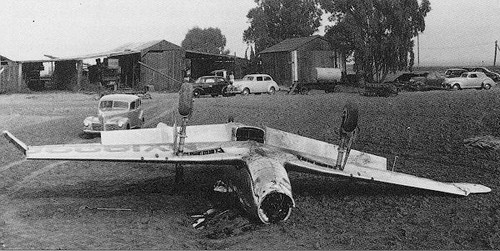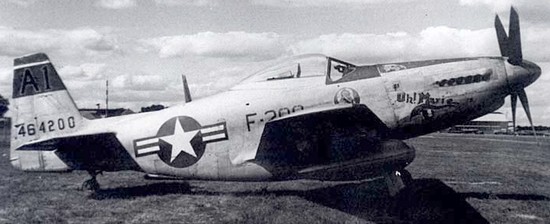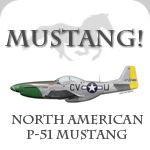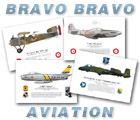Urban Legends
Most famous entities attract their share of legends and lies, and the Mustang is no exception. While some of these legends are rooted in truth, some are just plain... urban legends. While we do not pretend to answer all of these, here is a selection of the most interesting and amusing ones.
Plagiarism
One of the most classic P-51 issues. There are two versions of this claim: the first one states that the P-51's design owes nearly everything to the Curtiss XP-46, while the other version considers it as a copy of Germany's highly succesful Messerschmitt Bf 109 fighter.
As far as the Curtiss XP-46 claim is concerned, one has to go back to the beginning of the P-51's history to understand its origin. In 1940, the British Purchasing Commission was looking for combat aircraft in the US. The best fighter America could offer at the time was the Curtiss P-40 but Curtiss was busy producing the model for the USAAC and could not divert or increase production for the British. Since the BPC already knew NAA (they had already bought the successful Harvard/Texan trainer), they inquired wether the company would accept building the P-40 under license. "Dutch" Kindelberger replied that his company could design a totally new fighter with superior performance in as much time as would have been needed to install P-40 production lines. The BPC eventually accepted Kindelberger's proposition, which lead to the P-51.
However confident the BPC was in NAA's abilities, they knew that the company had never built a first-line fighter before and required that it purchase flight test and wind tunnel reports of the aborted Curtiss XP-46. The XP-46 was roughly similar in design to the P-51 with its underbelly radiator scoop. It was Lee Atwood, part of the P-51 design team, who made the trip to Buffalo to collect the data, for which NAA paid $ 56,000. Upon his return, chief aerodynamicist Ed Horkey examined the data and claimed it to be "obsolete and very amateurish". It would seem he promptly filed the reports and that they were never really used by NAA.
A variant of this legend claims the P-51 copied several designs of the P-40 prototype (the underbelly airscoop primarely). Wether it be the P-40 or the XP-46, it can hardly be said that the P-51 owes anything to these aircraft.
The other legend concerning the Bf 109 influence finds its root in yet another earlier fact. Rumor has it (and can be seen in several P-51 books) that Ed Schmued, arguably the most important man in the P-51's design, was an ex-employee from Messerschmitt who had worked on the Bf 109. While it is true that Schmued was born and bred in Austria and spoke English with a strong German accent, he had left Europe for Brazil in 1925 to work for General Motors before arriving in the US in 1930. Obviously he could not have worked for Messeschmitt, much less on the Bf 109.
Part of this rumor also came from the fact that the P-51 looked like the Bf 109. This caused friendly-fire problems during the entire war, and Mustangs were often painted with identification stripes to minimize this. Part of this was due to the fact that the Mustang was one of the rare Allied fighters to have square wingtips: most major WW2 Allied fighters were designed with rounded wingtips which at the time were thought (wrongly) to generate less drag than square ones. Allied ground defense personnel and fighters quickly learned that "square meant German", thus causing numerous identification mistakes with Mustangs.
The NA-73X crash
As Paul Balfour was flying the NA-73X protoype on its fifth test flight, the engine suddenly stopped. Balfour attempted a wheels-down landing in a freshly plowed field but, predictably, the aircraft flipped over on its back. Fortunately, it did not catch fire, as Balfour was stuck in the cockpit and had to be dug out. Several different causes to the crash were later exposed. The official version stated that Balfour had simply forgotten to change fuel tanks and that the engine had run out of gas, thus leading to the crash. Another version explains the short carburator scoop of the NA-73X was too short and could not "breathe" any air at high angles of attack.
 |
| The NA-73X after its crash. |
To this day historians disagree on the cause of the crash, but one would be tempted to think Balfour was not responsible for the crash. The technical explanation concerning the carburator scoop is perfectly plausible, and subsequent Mustangs were built with longer scoops, proving the inadequacy of the inital scoop shape and size. In addition, it seems hard to believe that Paul Balfour, an experienced test pilot, would have made such a mistake and - if he had - that he would have kept on as one of NAA's leading test pilots.
Instead one could suppose that the NAA design team quickly realized that the crash was due to the faulty carburator scoop. The answer to the problem was simple and rapidly implemented into the Mustang's design. The official report could have made Balfour responsible for the crash simply to prove the aircraft's design was not in question and that the program could continue. Obviously, it would have been in NAA's interest to do such a thing, which one could call a "white lie": the Mustang design was quite good except for some minor glitches, and blaming the responsability on Balfour (possibly with his knowledge and approval) was a logical "political" thing to do.
The 102 days
Quite a few sources claim the NA-73X was designed and built in 102 days. Although much less time was needed to design and build an airplane in the 1940's than nowadays, the Mustang's design was not quite that fast. First of all, Edgar Schmued and other engineers at NAA had been "preparing" a fighter for some time. Nothing definitive had been designed but when the BPC gave NAA the go-ahead agreement, NAA did not start to work from scratch.
This rumor is also linked to the fact that an informal agreement between NAA and the BPC was that the new design would be ready in 120 days. There was was no formal deadline concerning this, but NAA would have needed roughly 3 months to start license-producing the P-40, and Kindelberger's proposition was that NAA would design a new fighter within that time. The offer was accepted by the BPC on April 10 ,1940, and the first arrangements drawings were presented by NAA on April 24. The NA 73X prototype rolled out on September 9, 1940... without an engine, as the Allison V-1710 was to be used in priority for US fighters. The engine finally arrived on September 29, was installed on the NA 73X and roared to life for the first time on October 11. Finally, the NA 73X took its maiden flight on October 26, 1940, but the first production Mustang (AG345) rolled out on April 16, 1941.
While the Mustang was largely superior to the P-40, its design and production did take much longer than it would have taken to build the P-40 under license.
Apache dive brakes
There are persistent rumors that the A-36's dive brakes were useless or even dangerous to operate. It would seem the airbrakes would open at different speeds, resulting in instability during the dive or even spins and crashes. On this subject there several different claims exist. 1°) The dive brakes were dangerous and several pilots were killed during stateside training. Finally the dive brakes were wired shut and never used. 2°) The dive brakes were useless because they were too small. Rumor has it that officers in training schools said the brakes should not be used. 3°) A variant of the preceding, stating that the dive brakes were wired shut and rendered useless at the NAA plant (!), which presumably meant that NAA knew the dive brakes were useless and/or dangerous but didn't do anything about it. 4°) A final version which claims the dive brakes were effective and that the A-36A was extremely stable in a dive, resulting in high accuracy.
In this case it is hard to known the truth from the rest but this author would tend to think that the A-36A's dive brakes were indeed effective and used in combat. The large variety of "anti-brake" rumors makes it seem as urban legend material...
P-51Hs in combat
Did the P-51H lightweight Mustang ever see action? Popular belief is that it did, either in the Pacific at the end of World War II or in Korea. The P-51H prototype first flew on February 3, 1945 and was destined to be the main fighter in the invasion of Japan, alongside the P-47N. Although 370 aircraft had been delivered to units prior to VJ-Day, the P-51H was too late to see combat in World War II. A few units did however use the P-51H before the end of the war, but were not engaged in combat.
 |
| The P-51H Mustang, only Mustang version that was never used in combat. |
As for P-51Hs being used in Korea, no hard evidence can be found. The P-51D was preferred to the P-51H as it was sturdier and more resistant, and was the only Mustang version to see action in Korea. The P-51H was the only version of the Mustang never to see action, despite having the best performance of the entire Mustang family.
Going supersonic
A few pilots claimed to have reached the sound barrier (Mach 1) while diving with Mustangs. Presumably, pilots who engaged in power dives from high altitude actually experienced compressibility. According to Chuck Yeager, who can be considered knowledgeable on P-51s and Mach 1, anyone who would have reached, much less passed, Mach 1 with a P-51 would have ended with "his nose poking through earth all the way to China". The fact is that the Mustang could not reach, much less exceed, Mach 1. It could however, experience compressibility problems in an extended dive at full throttle, which is what most "transsonic-claiming" pilots actually experienced...
These amusing pieces of the P-51 Mustang's history are not the only ones of course. Other "urban legends" speak of corruption, major design faults or other things and should be considered the standard lot of any important factor in history.
This article was written by Gaëtan Marie. v 1.2. Any comments, corrections or additions welcome.
Advertising |

